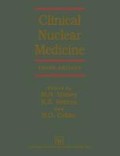Abstract
Occlusive disease of the peripheral arteries is a common cause of morbidity which is likely to increase further in an ageing population. The major underlying pathology is arterial atheroma, the effect of which can be modified and accelerated in patients with systemic hypertension or diabetes. The techniques described below are also applicable in patients with the less common varieties of peripheral arterial disease, including Raynaud’s syndrome, vibration white finger, Buerger’s disease, inflammatory vasculitides (e.g. Takayasu’s disease) and the various vascular entrapment syndromes.
Access this chapter
Tax calculation will be finalised at checkout
Purchases are for personal use only
Preview
Unable to display preview. Download preview PDF.
References
Blau, J.N. and Logue, V. (1961) Intermittent claudication of the cauda equina. Lancet, i, 1081–6.
Evans, J.G. (1964) Neurogenic intermittent claudication. Br. Med.J., 2, 985–7.
Wilkinson, D., Vowden, P., Parkin, A. et al (1987) A reliable and readily available method of measuring limb blood flow in intermittent claudication. Br. J. Surg., 74, 516–19.
Parkin, A., Robinson, P.J., Martinez, D. et al (1991) Radionuclide limb blood flow in peripheral vascular disease; a review of 1100 measurements. Nucl. Med. Commun., 12, 835–51.
Gehani, A.A., Thorley, P., Sheard, K. et al (1992) Value of a radionuclide limb blood flow technique in the assessment of percutaneous balloon and dynamic angioplasty. Eur. J. Nucl. Med., 19, 6–13.
Figar, S. (1959) Some basic deficiencies of the Plethysmographic method and possibilities of avoiding them. Angiology, 10, 120–5.
Baker, J.D. and DeEtte Dix, P.A.C. (1980) Variability of Doppler ankle pressures with arterial occlusive disease. An evaluation of ankle index and brachial : ankle pressure gradient. Surgery, 89, 134–7.
John, H.T. and Warren, R. (1961) The stimulus to collateral circulation. Surgery, 49, 14–25.
Grime, J.S., Critchley, M., Whitehouse, G.H. et al (1986) A method of radionuclide angiography and comparison with contrast aortography in the assessment of aorto-iliac disease. Nucl. Med. Commun., 7, 45–52.
Hayek, M.E., Ludwig, M.A., Fischer, K. et al (1988) The use of scintiangiography with technetium 99m in the diagnosis of traumatic pseudoaneurysm. J. Vasc. Surg., 7, 409–13.
Oshima, M., Ijima, H., Kohda, Y., et al (1984) Peripheral arterial disease diagnosed with high-count-rate radionuclide arteriography. Radiology, 152, 161–6.
Rhodes, B.A., Greyson, N.D., Seigel, M.E. et al (1973) The distribution of radioactive microspheres after intra-arterial injection in the legs of patients with peripheral vascular disease. Am. J. Roentgenol, 118, 820–5.
Lassen, N.A., Lindbjerg, I.F. and Dahn, I. (1965) Validity of the Xe 133 method for measurement of muscle blood flow evaluated by simultaneous venous occlusion plethysmography. Circ. Res., 16, 287–93.
Jelnes, R., Bulow, J. and Tonnesen, K.H. (1987) Subcutaneous adipose tissue blood flow in the forefoot during 24 hours. Labelling pattern and reproducibility. Scand. J. Clin. Lab. Invest., 47, 223–7.
Segall, G.M., Lang E.V., Lennon, S.E. et al (1992) Functional imaging of peripheral vascular disease; a comparison between exercise whole-body thallium perfusion imaging and contrast arteriography. J. Nucl. Med., 33, 1797–800.
Williams, C.A. and Lind, A.R. (1979) Measurement of forearm blood flow by venous occlusion plethysmography. Influence on hand blood flow during sustained and intermittent isometric exercise. Eur. J. Appl Physiol, 42, 141–9.
Miles, K.A., Barber, R.W., Wraight, E.P. et al (1992) Leg muscle scintigraphy with 99mTc-MIBI in the assessment of peripheral vascular (arterial) disease. Nucl. Med. Commun., 13, 593–603.
Bajnok, L., Kozlovszky, B., Varga, J. et al (1994) Technetium-99m sestamibi scintigraphy for the assessment of lower extremity ischaemia in peripheral arterial disease. Eur. J. Nucl Med., 21, 1326–32.
Krznaric, E., Nevelsteen, A., Van Hoe, L., et al (1994) Diagnostic value of 99mTc-d, l-HMPAO-labelled leukocyte scintigraphy in the detection of vascular graft infections. Nucl Med. Commun., 15, 953–60.
Brunner, M.C., Mitchell, R.S., Baldwin, J.C. et al (1989) Prosthetic graft infection: limitations of indium white blood cell scanning. J. Vase. Surg., 3, 42–8.
Parkin, A., Robinson, P.J., Wiggins, P.A. et al (1986) The measurement of limb blood flow using technetium-labelled red blood cells. Br.J. Radiol, 59, 493–7.
Parkin, A., Wilkinson, D., Smye, S.W. et al (1989) The clinical application of forearm and hand blood flow measurements using a gamma-camera. Surgery, 106, 26–32.
Parkin, A., Smye, S.W., Bishop, N. et al (1989) Forearm blood flow measurements using technetium-99m human serum albumin following brachial arteriotomy. J. Nucl. Med., 30, 45–50.
Greenstein, D., Parkin, A., Maughan, J. et al (1994) Perfusion defects in vibration white finger: a clinical assessment using isotope limb blood flow. Cardiovasc. Surg. , 2, 354–8.
Parkin, A., Maughan, J., Robinson, P.J. et al (1994) Radionuclide limb blood flow measurements to resolve diagnostic problems in vascular surgery. Nucl. Med. Commun., 15, 148–51.
Thorley, P.J., Sheard, K.L., Sivananthan, U.M. et al (1994) Limb blood flow measurement in technically successful balloon angioplasty. Br.J. Radiol, 67, 764–9.
Thorley, P.J., Sheard, K.L. and Rees, M.R. (1993) Does peripheral angioplasty compromise limb blood flow? Br. J. Radiol, 66, 506–9.
Editor information
Editors and Affiliations
Rights and permissions
Copyright information
© 1998 Springer Science+Business Media Dordrecht
About this chapter
Cite this chapter
Robinson, P.J.A., Parkin, A. (1998). Peripheral vascular disease. In: Maisey, M.N., Britton, K.E., Collier, B.D. (eds) Clinical Nuclear Medicine. Springer, Boston, MA. https://doi.org/10.1007/978-1-4899-3356-0_15
Download citation
DOI: https://doi.org/10.1007/978-1-4899-3356-0_15
Publisher Name: Springer, Boston, MA
Print ISBN: 978-0-412-75180-6
Online ISBN: 978-1-4899-3356-0
eBook Packages: Springer Book Archive

